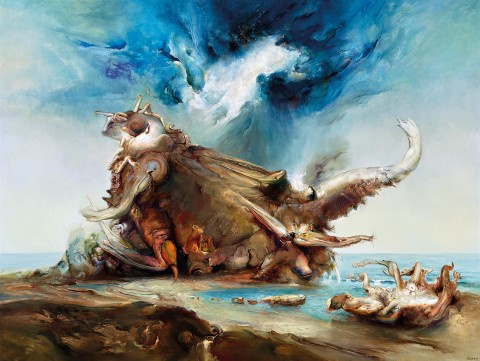SEA GUARDS, 1991
JAMES GLEESON
oil on canvas
172.0 x 230.0 cm
signed and dated lower right: Gleeson ‘91
signed and inscribed with title on stretcher bar verso: “SEA GUARDS” / James Gleeson
Lauraine Diggins Fine Art, Melbourne (label attached verso)
Private collection, Melbourne, acquired from the above in 1995
'As human beings we do not have the capacity to imagine the unimaginable. We can only project from a basis of the known. We can invent nothing that is entirely new. All that we can do is to bring together pre-existing realities in such new relationships as might surprise us into feeling that we have caught a momentary glimpse of something that had previously been hidden from us. Nothing is as strange or as various as Nature herself. She is the primal Surrealist’.1
Without doubt Australia’s leading Surrealist painter and poet, for more than six decades James Gleeson divulged the depths of his own imagination onto the canvas, offering up damning – yet simultaneously captivating – depictions of a visceral universe that defies intellectual grasp. With their typically ominous skies, huge grotesque forms and dominant motifs of metamorphosis, his landscapes are the manifestation of our inner psyche – powerfully capturing the repulsive, the erotic, the abject, and the tumultuous uncertainty of our dreams and subconscious thoughts. As Lou Klepac, author of several authoritative texts on Gleeson’s work, elucidates: 'Gleeson's paintings are the mirror which reveals the dark and dangerous regions which are too terrifying for our ordinary consciousness, because they represent a view of existence measured in light years where man's life is but a flicker of a small flame’.2
Monumental in scale and conception, Sea Guards, 1991 exemplifies magnificently the second period of Gleeson’s career during which, from 1983 until his death in 2008, ‘he embarked upon the large imaginative landscapes which constitute his greatest and most original achievement’.3 In stark contrast to his earlier explorations of ‘man as the measure of all things’, Gleeson now jettisons all interest in the representation of the human figure, transfixed instead by the mutability of forms and possibility of ‘a biomorphic cosmos’4 – as might have existed pre-civilisation, or might yet occur after the obliteration of humanity. As Gleeson asserts, ‘I got to the point where the extreme (of the figure) almost came to be recognisable – then I felt no need to use the form at all as an entirety. It could be represented by an arm, a hand, an eye. I broadened it to be not only landscape but cosmic experience’.5 That such anthropomorphic, pre-human forms are here set against an undulating, generative seascape signals further the evolution of Gleeson’s investigations into the subconscious and the representation of human form as allegory. Since the times of Greek mythology, the sea had been a poignant symbol of the unconscious – with the mutable, shape-changing sea god Proteus, son of Poseidon, subsequently defined by Swiss psychoanalyst, Carl Jung, as the personification of the unconscious. With its panoply of protean forms merging sea, land and sky, thus Sea Guards represents the culmination of the artist’s enduring fascination with links between the unconscious, Greek mythology and modern psychoanalysis, offering a masterful, evolved interpretation of the themes of transformation and metamorphosis that have long distinguished his unique vision. As Gleeson himself reflects, ‘the most important, constantly recurring motif throughout my work is a sense of the mutability of all forms and substances. Metamorphosis has always been, for me, one of the basic facts of life. Everything takes on a form, changes, falls apart and reforms in new organisations in an endless cycle’.6
1. Gleeson cited in Free, R., James Gleeson: Images from the Shadows, Craftsman House, Sydney, 1993, p. 11
2. Klepac, L., James Gleeson: Beyond the Screen of Sight, The Beagle Press, Sydney, 2004, p. 9
3. ibid., p. 13
4. Gleeson quoted in Free, op. cit., p. 43
5. Gleeson quoted ibid., p. 34
6. Gleeson quoted ibid., p. 43
VERONICA ANGELATOS
